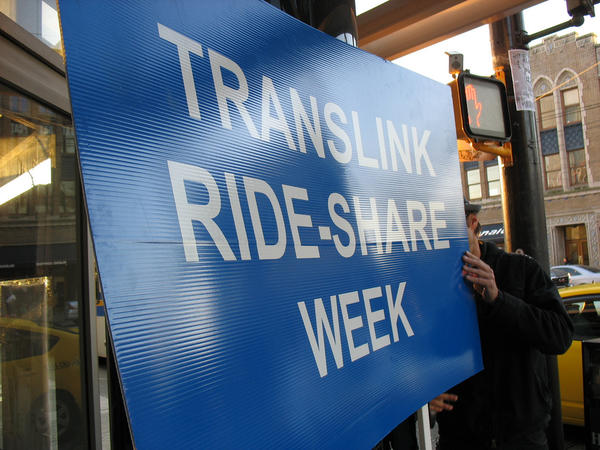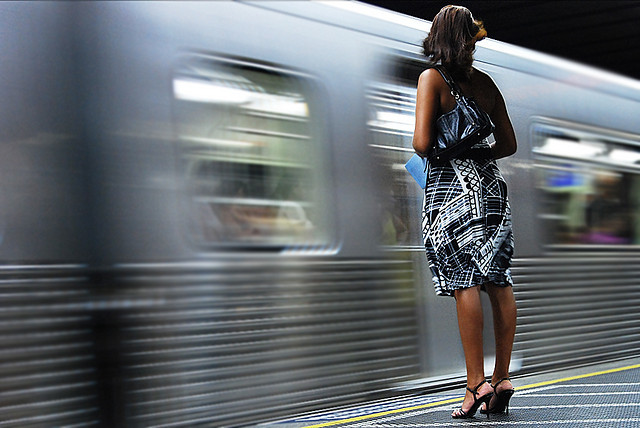Photo credit: Tar.Digital. This article is excerpted from the Policies for Shareable Cities report.
In the sharing economy, transportation is about accessibility, not ownership. By facilitating access to shared cars (carsharing), shared trips (ridesharing), and bikes (public bikesharing), cities can reduce road congestion and air pollution, reduce personal vehicle ownership and associated costs,1 reduce parking demand, repurpose valuable land dedicated to parking spaces,2 enhance mobility for those who do not own a car, and increase use of alternative modes of transportation like public transit, walking, or biking.3
Shareable transportation is a smart way to decrease our astounding levels of wasted and underutilized transportation resources. Privately owned vehicles in the U.S. sit idle more than 90 percent of the day, on average;4 carsharing reduces this waste while increasing car access.5 Ridesharing fills empty seats in private vehicle trips reducing road congestion and parking demand. Bikesharing systems around the world have increased cycling populations and supported a modal shift from motor vehicle travel to cycling,6 increasing transit connections and use, decreasing greenhouse gas emissions, and improving public health.7 These solutions convey noteworthy economic, time, public health, and environmental cost savings both to users and to cities.
Carsharing can take several forms. Models range from Personal Vehicle Sharing, or “Peer-to-Peer” (P2P)8, where individuals share access to personal vehicles in order to offset the costs of ownership, to “Business-to-Consumer” (B2C), where carsharing companies make their fleet of vehicles available to members of that service. Carsharing can be administered casually, such as by a group of neighbors who purchase a car for shared use, or it can be administered formally, such as by for-profit companies, governments, or nonprofits that own and operate a fleet of vehicles available to members at unattended access points throughout a region.
Ridesharing has recently been made simpler and more streamlined than ever, thanks to technological innovations that make it efficient to find a shared ride. Ridesharing can be facilitated in a variety of ways, including by nonprofit ride matching sites, ridesharing companies, employers, neighborhoods, and casual carpooling.
Public Bikesharing is an efficient, environmentally sound, and economically feasible form of public transportation9 that can even offer public health benefits. Intended for short distance trips between 0.5 to 3 miles,10 bikesharing systems allow flexibility to rent and return bicycles at any station across the region served and thereby facilitate one-way travel. Bikesharing addresses the "first and last mile" conundrum that is a challenge for public transit users and planners alike.11 Bikesharing systems can be privately operated, publicly owned and operated, and even run by community-focused non-profits.12
Shareable transportation is growing globally13 – and for good reason. It’s time for more cities to hop on board and reap the benefits. That said, the above recommendations should not be seen as a replacement for continued investment in public transportation such as subways, light rail, and bus. The new modes reviewed above should be integrated into transportation planning, complement if not stimulate use of existing public transportation, and offer the public additional transportation choices.
WHAT STEPS CAN A CITY TAKE TO PROMOTE SHAREABLE TRANSPORTATION?
1. DESIGNATED, DISCOUNTED, OR FREE PARKING FOR CARSHARING
We recommend that cities designate parking spaces for carsharing vehicles, particularly near public transit facilities and multi-unit housing.
Carsharing users most commonly cite convenient locations and guaranteed parking as major motivation for participation, and carsharing operators most commonly cite lack of access to a dense network of parking spaces for carsharing as a limit to expansion.14 Cities can therefore increase carsharing participation by making parking spaces available for shared vehicles both on streets and in off-street public lots and garages.15
City policies can include:
(a) provisions for on-street parking
(b) exemptions to parking time limits
(c) creation of carsharing parking zones
(d) free or reduced cost parking spaces or parking permits
(e) universal parking permits (i.e., carsharing vehicles can be returned to any on-street location)
(f) formalized processes for assigning on-street parking spaces16
Examples:
Washington, D.C. – D.C. began offering free on-street parking spaces to carsharing operators in 2005 and later auctioned 84 curbside spots to three operators, generating almost $300,000 in revenue. This pioneering parking strategy was a “win-win” for the city and carsharing providers, and added convenience for carshare users.17
San Francisco, CA – On July 1, 2013, San Francisco will extend its earlier six-month, on-street carshare parking pilot as a part of the SFMTA’s proposed carsharing policy.18 The idea behind leasing parking spaces to carsharing operators in densely populated areas is to increase visibility and accessibility of carsharing19. Meanwhile, the bulk of carsharing parking is provided off-street in municipal parking lots at a discounted carpool rate (approximately 50 percent of the full monthly rate).20
2. INCORPORATE CARSHARING PROGRAMS IN NEW MULTI-UNIT DEVELOPMENTS
We recommend that cities subsidize, incentivize, or require carsharing programs in new multi-unit developments. Close proximity of a carsharing vehicle relieves many households from needing a second car or from owning a vehicle altogether.21 The shared vehicle can be administered by a condo-owners' association or apartment management, or by a third party carsharing program.
Example:
San Francisco, CA – The city’s Planning Code now requires that newly constructed buildings provide permanent carshare parking spaces and that certain nonresidential developments dedicate 5 percent of their parking spaces to “short-term, transient use by vehicles from certified car sharing organizations” or other similar “co-operative auto programs.”22 OrdInance 286-10 authorizes the Planning Commission to require developers or project owners to pay annual carsharing membership fees for residents of new developments.23 In addition, the city granted a variance to construct the 141-unit Symphony Towers apartments with only 51 parking spaces (as opposed to the otherwise required 141), in part because of the commitment for two carsharing parking spaces and because the tenants were to pay extra for the use of a parking space, thereby disincentivizing car ownership.24
3. ALLOW RESIDENTIAL PARKING SPOT LEASING FOR CARSHARING
We recommend that cities allow residents to lease residential parking spaces for the purpose of parking shared vehicles.
By allowing residential driveways and parking spaces to be leased as an accessory or permitted use of a residential property, cities can enable homeowners to earn supplemental income for unused or underutilized residential parking, and create room for the growth of carsharing.
4. APPLY MORE APPROPRIATE LOCAL TAXES ON CARSHARING
We recommend that cities more closely align taxes on carsharing with the general sales tax for other goods and services.
Unreasonably high fees and taxes – originally intended to extract revenue from car rentals of airport travelers – are disproportionately affecting local carsharing users25 slow the growth of carsharing.26 Policymakers should use codified definitions or certification processes to distinguish between traditional car rental companies and carsharing organizations and ensure that only organizations generating significant public benefits would receive reduced taxation.27 At the very least, cities should make carsharing tax exempt in lower income urban areas with disadvantaged populations and high unemployment; foregoing tax revenue in these areas may be a small price to pay for the mobility benefits that sharing vehicles provides underserved residents.28 Examples:
Chicago, IL, Boston, MA, and Portland, OR – These cities have made noteworthy efforts to lower carsharing tax rates with political success. They make distinctions between carsharing and traditional car rental in their municipal codes.”29

A company-sponsored ride-share program in action. Photo credit: buzzerblog / Foter.com / CC BY-NC-ND.
5. CREATE ECONOMIC INCENTIVES FOR RIDESHARING
We recommend that cities create and promote economic incentives for ridesharing, like high-occupancy vehicle (HOV) lanes, designated or discounted parking, or waived or reduced tolls.
Cities can encourage carpooling by building or expanding HOV lanes along high- traffic routes. Demand for ridesharing typically exists along routes where carpooling lanes offer significant time savings or allow carpoolers to take advantage of direct economic incentives like waiver of tolls and discount parking.30
6. DESIGNATE RIDESHARING PICK-UP SPOTS AND PARK-AND-RIDE LOTS
We recommend that cities help meet demand for ridesharing by designating convenient locations as casual carpool pick-up spots and park-and-ride lots.
For decades, casual carpool, or “slugging," has been taking place in U.S cities with congested roadways, including in Washington, D.C, Houston, Seattle, and in areas where HOV lanes offer significant travel time reduction in peak travel times, like the San Francisco-Oakland Bay Bridge.31 Designating ridesharing pick-up spots is as easy as putting up a sign near a congested thoroughfare or freeway onramp to encourage carpoolers to gather, connect with drivers going the same way, and take advantage of the time and cost savings of HOV lanes.
In cases where ridesharing is not possible for one’s entire commute, park-and-ride lots make it possible for commuters to park and consolidate into fewer vehicles before embarking on the remainder of their trip. In many cases, cities do not even need to build new parking for this purpose, but could rather contract with parking lots that are typically not used during weekdays, such as church parking lots.
7. CREATE A LOCAL OR REGIONAL GUARANTEED RIDE HOME PROGRAM
We recommend that cities and regional agencies offer a Guaranteed Ride Home program to serve carpoolers in the event of unexpected emergencies.
Many people choose not to carpool because they feel insecure about the fact that they cannot leave work at any time in case of emergency. Cities and regions with Guaranteed Ride Home programs give carpoolers peace of mind by covering the cost of a taxi ride or rental car in the event of emergencies or in case of an unexpected departure of the carpool partner(s).
Examples:
Minneapolis, MN – The Guaranteed Ride Home program offers four rides or up to $100 (whichever comes first) each year to commuters who ride the bus, light rail, or carpool, vanpool, bicycle or walk to work or school at least three times per week.32
Other Cities with Similar Programs: Atlanta (five free rides per year)33, Baltimore/Central Maryland/D.C. Area (four per year)34, Alexandria, Virginia (four per year)35, Los Angeles (two per year)36, and many other cities.

Bikesharing in New York City. Photo credit: drpavloff / Foter.com / CC BY-NC.
8. ADOPT A CITY-WIDE PUBLIC BIKESHARING PROGRAM
The most common reason for not bicycling is lack of access to a bicycle.37 We recommend that cities create and manage city-wide bikesharing programs to provide that access.
Bikesharing programs enable individuals who may otherwise not use bicycles (i.e. tourists, individuals who do not own a bicycle, or those who do not have access to bicycle storage) to enjoy the benefits of cycling on an “as-needed” basis and without the responsibility of ownership.38
Sample Bikesharing Funding Strategies:
Washington, DC: The $6 million Capital Bikeshare program is funded by the U.S. Department of Transportation’s Federal Highway Administration under their Congestion Mitigation and Air Quality Improvement fund and other local funding.39
Minneapolis-Saint Paul, MN: Funding for the initial $3 million capital cost of launching Nice Ride included $1.75 million from the federal Non-motorized Transportation Pilot Program administered by Bike Walk Twin Cities and Transit for Livable Communities (TLC), as well as $1 million of tobacco settlement proceeds from Blue Cross and Blue Shield of Minnesota, and $250,000 from the Minneapolis Convention Center fund.40
Boston, MA: Boston’s Hubway bikeshare program is completely funded by grants totaling $4.5 million including $3 million from the Federal Transit Administration (FTA), $450,000 from the Boston Public Health Commission (BPHC) and $250,000 from the Metropolitan Planning Organiza- tion’s Congestion Mitigation and Air Quality (CMAQ) grant program.41
Denver, CO: Initial funding for B-Cycle came from a $1 million donation from the Denver 2008 Convention Host Committee, and Kaiser Permanente granted a three-year, $450,000 grant. Additional contributions came from key private foundations and corporations, making Denver B-Cycle entirely independent from city tax dollars.42
Recommended Guide: The FHA’s definitive 2012 guide for feasibility, implementation and evaluation of bikesharing operations in the U.S.43
1 Martin, Elliot and Susan Shaheen, “Greenhouse Gas Emission Impacts of Carsharing in North America,” IEEE Transactions on Intelligent Transportation Systems, Volume 12, Issue 4: 1074-1086 (2011).
2 Shaheen, Susan, Cohen, Adam, “Innovative Mobility Carsharing Outlook: Carsharing Market Overview, Analysis, and Trends,” Transportation Sustainability Research Center (5 Dec. 2012), https://tsrc. berkeley.edu/node/629.
3 Bieszczat, Alice, Schwieterman, Joe, “My Car, Your Car,” Magazine of the American Planning Association pp. 37-40 (May/June 2012).
4 Hampshire, Robert C., Gaites, Craig, “Peer-to-Peer Carsharing: Market Analysis and Potential Growth,” Transportation Research Record Vol 2217 (2011).
5 Cervero, Robert, “TOD and Carsharing: A Natural Marriage,” ACCESS, Vol 35 P. 28 (Fall 2009). 6 Shaheen, Susan, Guzman, Stacey, “Worldwide Bikesharing,” ACCESS, Vol 39 P. 24 (Fall 2011).
7 DeMaio, Paul. “Bikesharing: History, Impacts, Models of Provision, and Future,” Journal of Public Transportation Vol. 12, No. 4 (2009), https://nacto.org/wp-content/uploads/2012/02/Bike-sharing-Mod- els-of-Provision-Paul-DeMaio-09-12.pdf.
8 Shaheen, Susan, Mark Mallery, and Kingsley, Karla, “Personal Vehicle Sharing Services in North America,” Research in Transportation Business & Management (2012).
9 Shaheen, Susan, Guzman, Stacey, “Worldwide Bikesharing,” ACCESS, Vol 39 (Fall 2011), https://tsrc. berkeley.edu/sites/tsrc.berkeley.edu/files/Worldwide%20Bikesharing.pdf.
10 “Bike Sharing in the United States: State of the Practice and Guide to Implementation,” Federal Highway Administration, U.S. Department of Transportation (Sep. 2012).
11 “Seattle Bicycle Share Feasibility Study,” Bike-Share Studios, University of Washington College of Built Environments. Available at: https://www.bicyclinginfo.org/library/details.cfm?id=4719.
12 Shaheen, Susan, “Early Understanding of Public Bikesharing in North America,” CalACT 2012 Autumn Conference. Powerpoint Presentation p. 10 (Sep. 2012), https://www.calact.org/assets/confer- ences/2012%20Fall%20Conference/Bike-Sharing_Shaheen.pdf.
13 Shaheen, Susan, Cohen, Adam, “Growth in Worldwide Carsharing: An International Comparison,” Transportation Research Record: Journal of the Transportation Research Board 1992 pp. 81-89 (2007).
14 Id.
15 Shaheen, Susan, Adam P. Cohen, and Martin, Elliot, “Carsharing Parking Policy: Review of North American Practices and San Francisco, California, Bay Area Case Study,” Transportation Research Record: Journal of the Transportation Research Board 2187 (2011).
16 Id.
17 Bieszczat, Alice, Schwieterman, Joe, “My Car, Your Car,” Magazine of the American Planning As- sociation pp. 37-40 (May/June 2012).
18 SFMTA. Draft Car Sharing Policy and Pilot Project. January 31, 2013 (Unpublished, on file with author).
19 “San Francisco Begins On-Street Car Sharing Pilot: 11 On-Street Spaces to be Tested During Six-Month Pilot Starting Today,” San Francisco Metropolitan Transportation Authority Press Release (3 Oct. 2011), https://www.sfmta.com/cms/apress/SanFranciscoBeginsOn-streetCarSharingPilot11on- streetspacestobetestedduringsix-monthpil.htm.
20 Shaheen, Susan, Adam P. Cohen, and Martin, Elliot. “Carsharing Parking Policy: Review of North American Practices and San Francisco, California, Bay Area Case Study,” Transportation Research Record: Journal of the Transportation Research Board 2187 (2011).
21 Cervero, Robert, “TOD and Carsharing: A Natural Marriage,” ACCESS, Vol 35 P. 28 (Fall 2009).
22 San Francisco Planning Code Section 166(d)(1).
23 San Francisco Ordinance 286-10. Available at: https://www.sfbos.org/ftp/uploadedfiles/bdsupvrs/ ordinances10/o0286-10.pdf.
24 “Reforming Parking Policies to Support Smart Growth,” Metropolitan Transportation Commis- sion (June 2007), https://www.mtc.ca.gov/planning/smart_growth/parking/parking_seminar/Toolbox- Handbook.pdf.
25 Bieszczat, Alice, Schwieterman, Joe, “My Car, Your Car,” Magazine of the American Planning As- sociation pp. 37-40 (May/June 2012).
26 Bieszczat, Alice and Joseph Schwieterman, “Are Taxes on Car-Sharing Too High? A Review of the Public Benefits and Tax Burden of an Expanding Transportation Sector,” Chaddick Institute for Metro- politan Development, DePaul University (28 June 2011).
27 Id.
28 Id.
29 Id.
30 Poole Jr., Robert W. “Introducing Congestion Pricing on a New Toll Road.” Transportation, Vol. 19, Issue 4 (1992).
31 Kilborn, Peter T, “To Commute to Washington, the Early Bird Gets 'Slugs',” New York Times (29 April 2003), https://www.nytimes.com/2003/04/29/us/to-commute-to-capital-early-bird-gets-slugs. html.
32 See: “Guaranteed Ride Home,” MetroTransit, https://www.metrotransit.org/guaranteed-ride- home.aspx.
33 See: “Guaranteed Ride Home,” Georgia Commute Options, https://www.gacommuteoptions.com/ Commuter-Services/Make-It-Easier/Resources-Ridematching-Guaranteed-Ride-Home-and-Transit- Route-Info/Guaranteed-Ride-Home.
34 See: “Guaranteed Ride Home,” Metropolitan Washington Council of Governments, https://www. mwcog.org/commuter2/commuter/grh/index.html.
35 See: “Guaranteed Ride Home,” Department of Transportation & Environmental Services, https:// alexandriava.gov/localmotion/info/default.aspx?id=11138.
36 See: “Guaranteed Ride Home,” LA County Metropolitan Transportation Authority, https://www. metro.net/about/commute-services/guaranteed-ride-home/.
37 Royal, Dawn and Darby Miller-Steiger, “National Survey of Bicyclist and Pedestrian Attitudes and Behavior,” National Highway Traffic Safety Administration (Aug. 2008), https://www.nhtsa.gov/ Driving+Safety/Research+&+Evaluation/National+Survey+of+Bicyclist+and+Pedestrian+Attitudes+and +Behavior.
38 “Bikesharing,” University of California, Berkeley Transportation Sustainability Research Center, https://tsrc.berkeley.edu/bikesharing.
39 Shaheen, Susan, “What Makes Bikesharing Successful: Lessons Learned,” Presentation at LA Metro Bikesharing Workshop, Los Angeles, California (Dec. 2011). Available at: https://www.tsrc.berke- ley.edu/presentations.
40 Id.
41 Id.
##
Please support Shareable! Watch the two-minute video below & donate to our crowdfunder.









